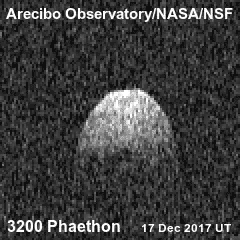(3200) Phaethon
|
Asteroid (3200) Phaethon |
|
|---|---|

|
|
| Properties of the orbit ( animation ) | |
| Orbit type | Apollo type |
| Major semi-axis | 1.2713 AU |
| eccentricity | 0.8900 |
| Perihelion - aphelion | 0.1398 AU - 2.4028 AU |
| Inclination of the orbit plane | 22.1804 ° |
| Sidereal period | 523.56 days |
| Mean orbital velocity | 26.42 km / s |
| Physical Properties | |
| Medium diameter | 6 km |
| Albedo | 0.107 |
| Rotation period | 3.6 hours |
| Absolute brightness | 14.6 mag |
| Spectral class |
Tholen: F SMASSII: B |
| history | |
| Explorer | IRAS |
| Date of discovery | October 11, 1983 |
| Another name | 1983 TB |
| Source: Unless otherwise stated, the data comes from JPL Small-Body Database Browser . The affiliation to an asteroid family is automatically determined from the AstDyS-2 database . Please also note the note on asteroid items. | |
(3200) Phaethon is a planetoid belonging to the group of the Apollo asteroids . These are celestial bodies crossing the Earth's orbit , whose major semi-axis is greater than 1 AU and whose perihelion distance is less than 1.017 AU.
The asteroid was October 11, 1983 by the infrared - Satellite IRAS discovered and after Phaeton , son of the Greek sun god Helios named.
Phaethon moves between 0.140 AU ( perihelion ) and 2.403 AU ( aphelion ) in around 524 days on a strongly elliptical orbit around the sun . The orbital eccentricity is 0.890, the orbit is inclined by 22.180 ° to the ecliptic .
Radar observations showed that Phaethon is an approximately spherical body, the diameter of which is approximately 6 km. It has a dark surface with an albedo of around 11%. The asteroid rotates around its own axis in around 3.6 hours.
Phaethon comes very close to the sun. In the perihelion it reaches a speed of 110 km / s (400,000 km / h) and surface temperatures over 700 ° C. Its orbit coincides with the elongated cloud of dust that causes the Geminids' meteor shower . Even so, it is not a comet: infrared images showed that its surface is made of solid rock. In 2013, the evaluation of measurements from the STEREO space probes showed weak signs of matter emissions from Phaeton; the dust probably dissolves due to the extreme temperature stress.
This and its low mass relative to the totality of the Geminids led to the theory that an event such as e.g. B. a breakup of (3200) Phaethon could be the origin.
exploration
According to NASA, Phaethon approached Earth to within 0.069 AU on December 16, 2017 and was examined on this occasion by the Goldstone Complex together with the Arecibo Observatory using radar. The resulting images had a resolution of 75 m / pixel. For 2093, 0.019 AU is predicted to be the closest approach since its discovery.
In a bilateral research mission called DESTINY PLUS of the German Aerospace Center (DLR) and the Japanese Space Agency (Japan Aerospace Exploration Agency, JAXA) agreed in 2016 , a space probe is to explore the asteroid. It is expected to reach the asteroid Phaeton about four and a half years after launch and explore it during a dense flyby.
literature
- J. Hanuš, M. Delbo et al .: Near-Earth asteroid (3200) Phaethon: Characterization of its orbit, spin state, and thermophysical parameters . Ed .: A & A. Band 592 , A34, August 2016 ( aanda.org ).
credentials
- ↑ DC Agle, Dwayne Brown, Suraiya Farukhi: Arecibo Radar Returns with Asteroid Phaethon Images. NASA, December 22, 2017, accessed January 10, 2018.
- ↑ 3200 Phaethon (1983 TB) . JPL Small-Body Database, accessed January 10, 2018.
- ↑ Frankfurter Allgemeine from September 22, 2013 (last third of the article)
- ↑ NASA ScienceCassts: Rock Comet Sprouts a Tail , YouTube, accessed December 1, 2013
- ^ "Goldstone Radar Observations Planning: Asteroid 3200 Phaethon" NASA.gov dated December 14, 2017
- ↑ a b Expansion of German-Japanese cooperation in space - joint projects on cosmic dust and internal combustion engines. November 2, 2017, archived from the original on February 3, 2018 ; accessed on February 3, 2018 .